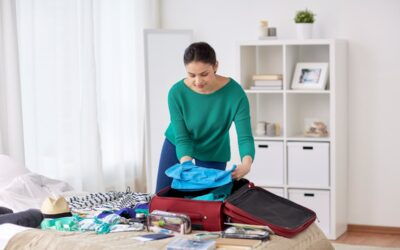Last updated on June 9th, 2024
Featured image: Planning for long trips takes a bit more consideration. Use this checklist to get started. | Photo by Hoverstock on Envato
First-hand tips to make long-term travel affordable and safe
by Carolyn Ray
Leaving your home base for months at a time can sound intimidating, but there are many women who are making a go of it, including me. For the past three years, I’ve practiced the art of the longer stay, living for months at a time in countries like Mexico, Spain and Italy. This year, after our 30th-anniversary cruise in November, I plan to spend several months abroad and haven’t quite decided when or if I’ll return to Canada.
This kind of lifestyle requires planning to make it both affordable and safe. For those who are considering a semi-nomadic lifestyle, here are my tips to prepare and make your time on the road fun and fulfilling.
Planning for long trips
Planning for a long stay is a bit of a brainstorming process. I start with a list of everything I think I might want to bring, and as the departure date draws closer, start to consider what I really need versus what I really want.
The Must-Haves
Check your passport: Many countries won’t allow entry unless your passport is dated at least six months before your arrival. You also have to keep an eye on tourist visa timelines, particularly in the Schengen Zone.
Check travel visas and vaccinations: Are travel visas or vaccinations required for where you want to go? Find out by checking your country’s government travel advice websites. Need a visa? Check here for more information.
Travel Insurance: Make sure you have comprehensive travel insurance for a longer stay. I have annual insurance, which allows for a maximum of 30-day trips, and then top it up as needed for additional trips. I find this is cheaper than buying three-month packages.
Register with the government: You never know when a natural disaster might happen. While I was in Mexico in April 2022, there was a very early hurricane in Huatulco. When I was in Egypt in October 2023, war broke out in Israel and Gaza. Make sure you’re signed up with Canadians Abroad or the US Government’s STEP program.
Manage your mail: I don’t get much mail anymore but one of the things you can consider is moving to electronic statements versus printed statements.
Access to your condo or home: Ask a trusted friend, family member or property manager to keep an eye on your home while you’re away. This person could also check your mail and make sure that there’s nothing important in there!
Bank Accounts: If you own a business, as I do, make sure that someone else has signing authority on your account, just in case.
Medical supplies: As a migraine sufferer, I need to make sure I have enough medication for at least 3-4 attacks while I’m travelling. I also pack bandaids, aspirin, vitamins, seasickness pills and cold medication as I tend to get sick near the end of trips. Having 2-3 extra pairs of contact lenses is a must for me, plus my backup glasses, although I can usually find cleaning solution anywhere. Make sure you have a copy of your prescription just in case. Pre-menopause, I learned that tampons can be hard to find in certain countries, but thankfully that’s not an issue anymore!
Pets: While my days of dogs, cats, guinea pigs, hamsters and geckos are over, there are many options to have pets looked after. Trusted Housesitters offers a service to have people stay in your home and look after your pets, which could be a consideration.
Saving money
Cancel your subscriptions: I don’t have cable TV anymore, but I do use streaming services and Internet. The internet service can be paused (although irritatingly, there is a charge for that), and the streaming services can be cancelled unless you want to watch while you’re travelling. I usually cancel Apple TV and Amazon Prime but keep Netflix as I find most Airbnbs have Netflix and I may need to sign in.
Pause your gym or other memberships: I belong to a yoga studio and fortunately, they offer flexible membership packages that allow me to cancel and then restart when I’m home. If you belong to a coffee, wine, or other club, put the membership on pause until you return.
Check your home insurance: You don’t want your house/car insurance to expire while you’re overseas, so make sure everything is paid up and current.
Reduce your mobile coverage and use an eSim: For three years, I’ve used an Airalo eSim, which saves quite a bit on roaming charges. In Europe, I purchased the regional SIM which covers 39 countries. You can also purchase eSIMs by country. An eSIM can cost as little as $5 a week, or you can purchase 30-day packages for $15, much less expensive than roaming packages offered by mobile carriers.
Exclusive for JourneyWoman readers: Save 10% off your next Airalo eSIM purchase by clicking this link and using the code JOURNEY10.
Load a Wise card: For small local purchases overseas, I use Wise to tap and pay, rather than needing cash on hand or my credit card, which charges for foreign currency transactions. For example, I budget $200 for small expenses like transit or coffee, and put the equivalent in local currency on my Wise card. This is particularly helpful with transit in Europe, which doesn’t require a separate card anymore. One of the things I like about Wise is that I can easily transfer currencies on the app. For example, if I have 10 euros left in my Wise account, I can easily transfer that to UK pounds with the touch of a button.
Technology tips
Make sure your computers and phones are working: For those who might be working remotely, having a functional computer is essential. On my last trip, this wasn’t the case, so I now bring an older extra computer with me on longer trips. For phones, I suggest you bring an extra one in case you lose yours. You can either use an old one or buy a refurbished one online. Make sure your apps on your phone are updated.
For accessories, I bring a flash drive, backup battery, extra power cord and electrical adapter – I use this one from Amazon. Last year in Europe, I purchased a European charging plug for my Apple computer to plug in normally instead of using an adapter. As Apple users know, this can be swapped out depending on what country you’re in. I use iCloud to back up all of my data, which costs $9.99 a month.
Apps on your phone: We all have our go-to apps to help with travel. Here are mine: WhatsApp, Airalo eSIM, Wallet (to store tickets, Wise and payment cards), Trainline (for Europe), Booking.com and Google Translate. Before I leave, I load train and airline apps specific to my destination and then delete them when I return.

Sort all your finances and technology before you leave makes planning for long trips easier / Photo by voronaman111 on Envato
Change your voicemail message: My voicemail now perpetually says that the best way to reach me is through email instead of leaving a voicemail. I don’t give out any details or even mention I’m away.
Set up two-factor authentication: Two-factor, or two-step, authentication is a way to protect access to your accounts. Not only do you log in with a password, but you are asked for a code. For example, when you log into your email, you may be asked to provide a second code through your phone. However, I’ve learned the hard way that push notifications on my phone don’t always work, even with a SIM card. I now use Google Authenticator as my second step of authentication for all of my financial apps, email, Wise, Facebook and even Amazon.
Protect your data: When you’re using public wifi, you are putting all of the information on your phone at risk. I recommend using a Virtual Private Network (VPN) app such as Nord VPN, that blocks attackers from getting your data. I also use Norton AntiVirus on my computer and phone to stop hackers from accessing my data.
Read More: 12 Cyber Security Travel Tips For Women
Before you leave, make sure to…
Test your Apple Airtags: I use Apple Airtags to track everything, and have my notifications set up to receive alerts immediately should I walk away from my bag. I have Airtags in my computer bag, cross-body bag, backpack and suitcase. And I always bring extra batteries just in case. Make sure you test and name your Airtags before you leave.
Bring printed copies: I use plastic folders to store and collect all of my travel information, and print airline, train and hotel confirmations, as well as a copy of my travel insurance. I use this folder to collect brochures, tickets and other things that help me write articles afterwards.
Pack your safety items: I never leave home without a rubber doorstop (in fact, I always keep a pack of three), and sometimes I even give one out to solo women I meet during my travels. I always have a headlamp (make sure you have an extra battery) and if I’m staying in an Airbnb, I bring my own CO2 detector.
Many of our readers are also nomadic or stay longer in places. Here are their tips on planning for long trips:
This past fall I travelled alone to Almaty, Kazakhstan and the week before leaving I took screenshots of the Canadian Embassy details (phone number and address in Astana). This made me feel safer (even though I ended up feeling incredibly safe and relaxed in Almaty) but I think next time I travel to a more off-the-beaten-track destination I’d register here in Canada too. — Becky L.
I don’t like to pay bills over the phone when travelling. Almost all are on auto-pay, except for my credit card which I pay in full every month, so I try to anticipate spending and set up generous payments for the months I am away. I am okay with having a little credit on the balance when I get home. — Maria F.
I stay for two months in India and have done so for the last 23 years. My list includes: 1) Yoga mat….never leave for anywhere without it. 2) Extra supplements (just in case). 3) Additional hand cream/SPF (container) as I know how long it lasts for one month. 4) Definitely an extra bag for market shopping & take-out dinners. 5) Mini umbrella (but ditched that on recent trips). 6) Printed itinerary as in India they sometimes check if you have a flight out and 7) extra socks (1 pair). — Heather M.
More Travel Tips
Ten Money-Saving Tips for Your Next Adventure Trip
Whether you plan your own travels or prefer guided tours, these money-saving travel tips will help you plan a successful adventure trip.
Accessible Adventures in Albania: An Off-Season Road Trip is Full of Surprises
A off-season road trip through the southern part of Albania showcases stunning coastal villages, ancient ruins, and picturesque landscapes
Packing for Long Trips: How Women Can Pack Smart and Be Comfortable
Travelling for long trips is exciting but comes with more considerations. Here’s what women should remember when packing for long trips.








Great list, picked up a couple of ideas for myself. Thanks Carolyn.
If you are in the US, you can sign up for USPS Informed Delivery and get an email with pictures of the day’s mail. I find it helpful whether I am home or traveling, to stay on top of essential items.